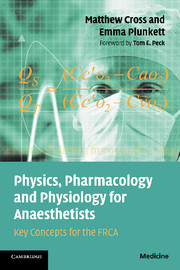Book contents
- Frontmatter
- Contents
- Acknowledgements
- Preface
- Foreword
- Introduction
- Section 1 Mathematical principles
- Section 2 Physical principles
- Section 3 Pharmacological principles
- Section 4 Pharmacodynamics
- Section 5 Pharmacokinetics
- Section 6 Respiratory physiology
- Section 7 Cardiovascular physiology
- Section 8 Renal physiology
- Section 9 Neurophysiology
- Section 10 Statistical principles
- Appendix
- Index
Introduction
Published online by Cambridge University Press: 15 January 2010
- Frontmatter
- Contents
- Acknowledgements
- Preface
- Foreword
- Introduction
- Section 1 Mathematical principles
- Section 2 Physical principles
- Section 3 Pharmacological principles
- Section 4 Pharmacodynamics
- Section 5 Pharmacokinetics
- Section 6 Respiratory physiology
- Section 7 Cardiovascular physiology
- Section 8 Renal physiology
- Section 9 Neurophysiology
- Section 10 Statistical principles
- Appendix
- Index
Summary
This book is aimed primarily at providing a reference point for the common graphs, definitions and equations that are part of the FRCA syllabus. In certain situations, for example the viva sections of the examinations, a clear structure to your answer will help you to appear more confident and ordered in your response. To enable you to do this, you should have a list of rules to hand which you can apply to any situation.
Graphs
Any graph should be constructed in a logical fashion. Often it is the best-known curves that candidates draw most poorly in their rush to put the relationship down on paper. The oxyhaemoglobin dissociation curve is a good example. In the rush to prove what they know about the subject as a whole, candidates often supply a poorly thought out sigmoid-type curve that passes through none of the traditional reference points when considered in more detail. Such an approach will not impress the examiner, despite a sound knowledge of the topic as a whole. Remembering the following order may help you to get off to a better start.
Size
It is important to draw a large diagram to avoid getting it cluttered. There will always be plenty of paper supplied so don't be afraid to use it all. It will make the examiner's job that much easier as well as yours.
Axes
Draw straight, perpendicular axes and label them with the name of the variable and its units before doing anything else.
- Type
- Chapter
- Information
- Physics, Pharmacology and Physiology for AnaesthetistsKey Concepts for the FRCA, pp. 1 - 4Publisher: Cambridge University PressPrint publication year: 2008



